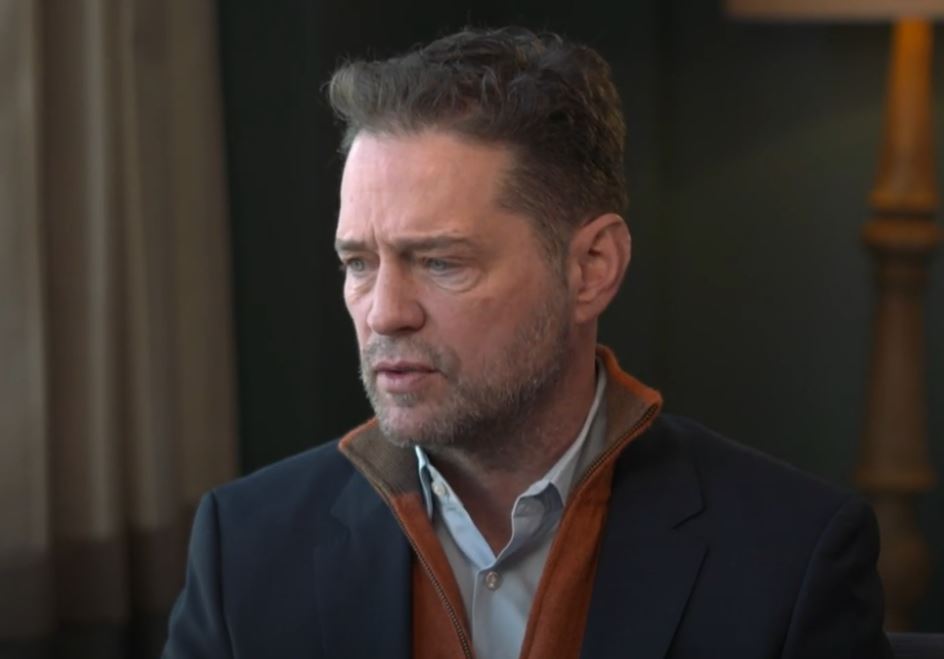With an official height of 5 feet 6½ inches, Jason Priestley has long been the subject of casual fascination, fan debate, and even on-screen illusion. Although the number doesn’t seem noteworthy at first, it has quietly influenced perception and narrative in Hollywood, where appearances determine careers.
Priestley’s breakthrough performance as Brandon Walsh on Beverly Hills, 90210, radiated a grounded charm that didn’t necessitate dominating others. His consistent confidence and relatable appeal were what made him stand out, not his size. The visual gymnastics that the producers used to achieve height parity among the cast members were frequently missed by viewers who were engrossed in the drama and youth culture of the show. Despite being noticeably taller than actors Ian Ziering (5’11”) and Luke Perry (5’10”), Priestley never seemed to be overshadowed by their stature thanks to deft blocking, well-chosen footwear, and well-tailored framing.
Jason Priestley Bio & Career Details
| Detail | Information |
|---|---|
| Full Name | Jason Bradford Priestley |
| Date of Birth | August 28, 1969 |
| Birthplace | Vancouver, British Columbia, Canada |
| Nationality | Canadian-American |
| Profession | Actor, Director, Producer |
| Notable Role | Brandon Walsh in Beverly Hills, 90210 |
| Listed Height | 5 ft 6½ in (1.69 m) |
| Years Active | 1978–present |
| Spouse | Naomi Lowde (m. 2005) |
| Children | Two |
| Major Works | Private Eyes, Call Me Fitz, 90210 |
| Official Source | Jason Priestley – Wikipedia |
Digital platforms and fan forums have rekindled interest in his height during the last ten years. Like sports cards, fans share theories and firsthand observations on Reddit and in comment threads. Some claim he appeared shorter in person, while others recall instances in which he looked directly at his taller co-stars. Priestley appeared “several inches shorter” than anticipated at a book signing, according to one user, while another pointed to his shoes on Private Eyes and speculated about possible hidden lifts. Despite their lightheartedness, these tales highlight a larger cultural interest in image and authenticity.
Priestley has used wry humor to address the topic on occasion; he once joked that “there’s a lot of bad intel out there.” His self-awareness, which is especially welcome, has enabled him to handle speculation tactfully rather than defensively. His relationship with fans who value celebrities who don’t take themselves too seriously has only grown stronger as a result of his open and honest approach.
In the 1990s, height was frequently used as a symbol of authority or desirability in the television industry, which continued to rely heavily on traditional male archetypes. Priestley, who was noticeably shorter than that stereotype, broke it by starring in one of the most famous teen dramas of the decade. He wasn’t a violent or controlling person. Rather, he portrayed the show’s moral compass—reasonable, considerate, and likeable. At the time, it was especially novel to subtly challenge the alpha male stereotype.
Recent years have seen a resurgence of interest in the possible physical effects of his racing accident from 2002. It was questioned whether the incident, which resulted in a fractured spine, could have caused him to become somewhat shorter. Despite the possibility of compression or misalignment, no verified post-accident measurement has been made public. In any case, the rumors have sparked further debate about how we evaluate public figures’ physical characteristics.
Standing next to different co-stars, Jason’s height has also become a visual reference. The difference between Shannen Doherty (5’1¾”) and Jennie Garth (5’5″) was negligible. However, the difference became more apparent when they were paired with taller actors or athletes in subsequent appearances. However, Priestley’s posture and shoulders back greatly diminished the emphasis on vertical inches. No tape measure could ever adequately convey the size of his presence.
Producers made sure that his height never diminished his credibility as a leading man by working with seasoned stylists and set designers. The same methods—low-angle shots, proportionately styled sets, and clothing choices that added visual elevation—were used in Call Me Fitz and Private Eyes. This painstaking backstage work was especially helpful in maintaining the illusion without going overboard.
Priestley’s versatility is further demonstrated by his ability to switch from actor to director. His vision, talent, and storytelling instinct took precedence over height as he positioned himself behind the camera. His work directing 90210, Call Me Fitz, and The Secret Life of the American Teenager episodes was incredibly successful, demonstrating that creative authority comes from insight rather than size.
His choice to leave Los Angeles and move his family showed a commendable sense of perspective. He separated himself from the constant scrutiny of Hollywood aesthetics by putting his family before fame. Young actors received a strong message from that subtly executed move: you don’t need to follow a physical blueprint to succeed.
Priestley’s career is particularly resilient in light of shifting industry standards. His journey is more pertinent than ever as conversations about authenticity, image manipulation, and body diversity continue to develop. Although he wasn’t particularly tall by casting standards, he made a significant impression and provided a precursor to the idea that charisma and emotional intelligence can surpass physical attributes.
Fans who rewatched 90210 on streaming services during the pandemic frequently remarked on how young Priestley appeared next to his co-stars, with some pointing out that his small frame gave the impression that he was older than he actually was. Brandon Walsh never appeared to age during the ten-year run of the show, which is a testament to both his physicality and nuanced performance.
Jason’s story fits in with the growing popularity of unconventional actors. Priestley serves as a reminder that size does not equate to content, much like Peter Dinklage reinterpreted the function of height in drama and Kevin Hart uses it as comedic power. He is actively redefining success for upcoming generations by acting, directing, and mentoring.



